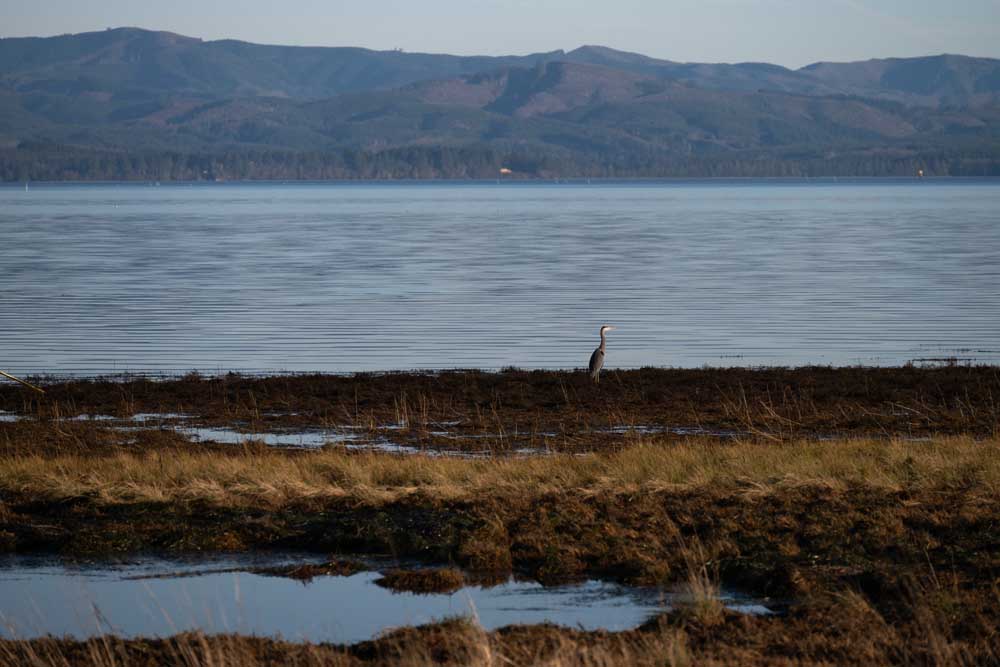Step into the past in Oysterville
Published 9:00 am Monday, December 16, 2024

- A heron perches on the edge of the bay.
The pioneer village of Oysterville rose from the waters fronting Willapa Bay in 1854. Two men, Robert Hamilton Espy and Issac Alonzo Clark, were lost on the bay in a borrowed Chinook canoe, overcome by a heavy rainstorm.
Legend says that Chief Nahcati beat a spruce club on a hollow log and guided the men safely to shore. They came, marveled at the opportunity — mounds of oysters — and stayed. The two pioneer minds were churning over the promise of profits.
Within a few years, the village grew exponentially. Five streets. One hotel. Two bars. One church and then two. And then more — for a while. The word of God spread up and down the narrow dirt streets like the clarion call of all the pretty voices emanating from the Sunday choir.
The church still stands proudly in this idyllic town on the north end of Washington’s Long Beach Peninsula, and sweet voices ring during vespers.
Back in Oysterville’s early days, children were frequently home-educated, but that only went so far. Next came the little red schoolhouse — the first school, built in 1863 — just across the street from what was then the Pacific County seat.
That monument to education was replaced as the population swelled. The second incarnation consisted of two stories (two classes, young and older) and suffered the fate of so many old wooden buildings. It burned to the ground.
The village was growing, with the largest concentration of folks on the Northwest Coast: 25 houses, maybe 150 people. But then, in the middle of the night, in 1892, the county seat and its records were stolen by the city fathers from South Bend, a hard sail across the long, choppy bay.
To make matters worse, a year later the Clamshell Railroad stopped short of Oysterville and profits — along with a building spree — filtered south to Nahcotta. Finally, in 1907, a third school was completed, a modest affair, as the population had declined. It was built with the best of intentions. The school remains a community center. Charm drifts off its weathered boards like rainwater.
What is time but a long story? In Oysterville, it unfolds like the tides, high and low, the predictable ebb and flow of good years and bad.
In the beginning here were the Chinook people. On these shores, they built and lived, loved and died, generation after generation, replicating the lessons handed down by the elders. The same could be said of the pioneers who came later.
The Chinook called this place “tsako-te-hahsh-eetl,” meaning “place of the red-topped grass” or “home of the yellowhammer,” the red-shafted flicker. They returned each fall to winter beside the seafood-rich waters.
In the long, wet winters, they huddled inside their planked lodges. Children learned their lessons, memorized languages, and were taught their skills and crafts.
The famous wordsmith, Willard Espy — along with his six siblings — also learned his ABCs here. Always precocious, he passed through the 10th grade in this plain building before attending college. He stands out as Oysterville’s famous academic. In her older years, his sister, Dale Espy Little, became the grand dame of Oysterville, always with a smile and a story to tell. Her dry sense of humor was legendary.
For 50 years, children with fire in their bellies were educated in this plain wooden building. Initially, pioneer men arrived at Pacific County without their better halves. Children were not in abundance.
It’s easy to imagine these kids with their armloads of books and plain, brown-bagged lunches scampering in the rain down the worn footpaths that led to the simple schoolhouse. It’s easy because the old school stands on the same property as it has for over ten decades.
If the village remains charming, a good part of all that is in the gatherings on cold, wet nights when the southwest wind curls off Willapa Bay and the rain falls in torrents. Folks congregate to hear a lecture, a dissertation — or to potluck — in the fine straight-grained wooden structure.
The first schoolhouse was built from redwood boards carted from San Francisco as ballast in one of many two-masted schooners that struggled across the Shoalwater Bar. Of the second school, nobody is sure. But the third stands resolutely in place for all with eyes to see.
Yes, Oysterville has a wonderful church. Yes, the village is designated on the National Register of Historic Places. It nestles among ancient spruce trees — part of the main street is lined with cypress — on a photogenic peninsula full of rich history.
But it just might be the ghosts of those children, their voices playing out their first alphabet, their first reports, or memory lessons that cling to the soft, salty air while the world moves on at bullet speed.
You are invited to walk these same streets, though several have eroded back into the bay. You are further invited to partake in a church service or listen to a handful of scholars as they share their lore. Or sample the town’s briny feast at Oysterville Sea Farms by the bay.
But mostly, you are encouraged to remember another time and place that shines in memory just as the sun rises over Willapa Bay on those perfect mornings when the world is aglow.
Please, come and enjoy but remain respectful. Several of the ancestors of those first pioneers still walk the streets, their eyes and ears wide open, but, most likely, their hearts remain in the past.





